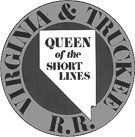Steamboat
Discovered by emigrants headed westward toward Sacramento in the 1840s, Steamboat was named for its plumes of steam which resembled the steamboats that were a familiar sight in the East along the Mississippi and Missouri Rivers. At the time, a 70-foot geyser shot into the air and was regarded as the third largest in the United States.
Steamboat's first commercial development came in 1859 when Felix Monet built a small bathhouse. A hotel was built in 1860, and in 1861 Dr. Joseph Ellis opened a hospital using the springs for healing waters. When the Virginia & Truckee Railroad line was extended to Reno in 1871, Steamboat was selected as a station and a daily train connected Steamboat with downtown Reno - a thirty minute train ride. Steamboat grew as a town, and by the end of the century had the large Grand Hotel, saloons, a dance hall, stagecoach station, and two V&T Railroad buildings. The town prospered, and the springs were visited by wealthy entrepeneurs and politicians, including President Ulysses S. Grant.
On December 10, 1900, a large earthquake shook Steamboat. As a result, the geyser and many of the pools dried up. The following April, a fire burned much of town, including the Grand Hotel. Some companies continued to use what remained of the once great springs, and for a time the largest pool in Nevada was in operation nearby. Newer resorts such as Moana Hot Springs and Lawton's opened closer to Reno, and Steamboat's business faltered. The large pool was drained, and the V&T daily service ended by 1950. Today, Steamboat Springs is open as a health resort with buildings dating back to the early 1900s. A geothermal power plant also operates nearby. The turntable from Steamboat's V&T roundhouse can be found as part of a bridge in Carson River Canyon.











